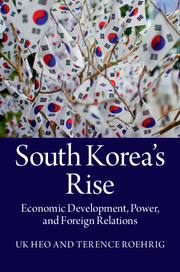Book contents
- Frontmatter
- Dedication
- Contents
- List of figures
- List of tables
- Acknowledgements
- 1 Introduction
- 2 Economic development, state power, and foreign policy
- 3 Inter-Korean relations: confrontation, economic exchanges, and the nuclear crisis
- 4 South Korea and the United States: from dependency to partnership
- 5 South Korea, Russia, and China: from adversaries to economic partners
- 6 South Korea and Japan: an ambivalent relationship
- 7 South Korea and the European Union: evolving cooperation and competition
- 8 South Korea and India: opportunities and obstacles
- 9 South Korea and the developing world: Africa, Latin America, the Middle East, and Southeast Asia
- 10 Contributing to the international community: from consumer to producer
- 11 Conclusion
- Bibliography
- Index
- References
5 - South Korea, Russia, and China: from adversaries to economic partners
Published online by Cambridge University Press: 05 July 2014
- Frontmatter
- Dedication
- Contents
- List of figures
- List of tables
- Acknowledgements
- 1 Introduction
- 2 Economic development, state power, and foreign policy
- 3 Inter-Korean relations: confrontation, economic exchanges, and the nuclear crisis
- 4 South Korea and the United States: from dependency to partnership
- 5 South Korea, Russia, and China: from adversaries to economic partners
- 6 South Korea and Japan: an ambivalent relationship
- 7 South Korea and the European Union: evolving cooperation and competition
- 8 South Korea and India: opportunities and obstacles
- 9 South Korea and the developing world: Africa, Latin America, the Middle East, and Southeast Asia
- 10 Contributing to the international community: from consumer to producer
- 11 Conclusion
- Bibliography
- Index
- References
Summary
After Korea was divided into two in 1945, the Soviet Union was North Korea’s patron throughout the Cold War period. China also became North Korea’s close ally after a Chinese communist regime was established in 1949. When the Cold War ended, however, the relationship between South Korea and these two countries started changing, largely because South Korea’s economy rose to the twelfth largest in the world, making the ROK an attractive economic partner even at the expense of their ties with Pyongyang.
In 1990 Russia established normal relations with South Korea. Trade between the two countries increased annually and reached $22 billion in 2012. The political relationship has also improved. After normalization, South Korea provided $1.5 billion in loans to the Soviet Union in 1991 and later another $1.5 billion to Russia. As part of the loan repayment, Russia, the successor to the Soviet Union, provided weapons systems to South Korea. This arms transaction is unique because it was done between two former adversaries without commercial benefits or ideological solidarity, the typical motives of an arms transaction. This relationship was possible thanks to South Korea’s economic prosperity.
- Type
- Chapter
- Information
- South Korea's RiseEconomic Development, Power, and Foreign Relations, pp. 67 - 87Publisher: Cambridge University PressPrint publication year: 2014

